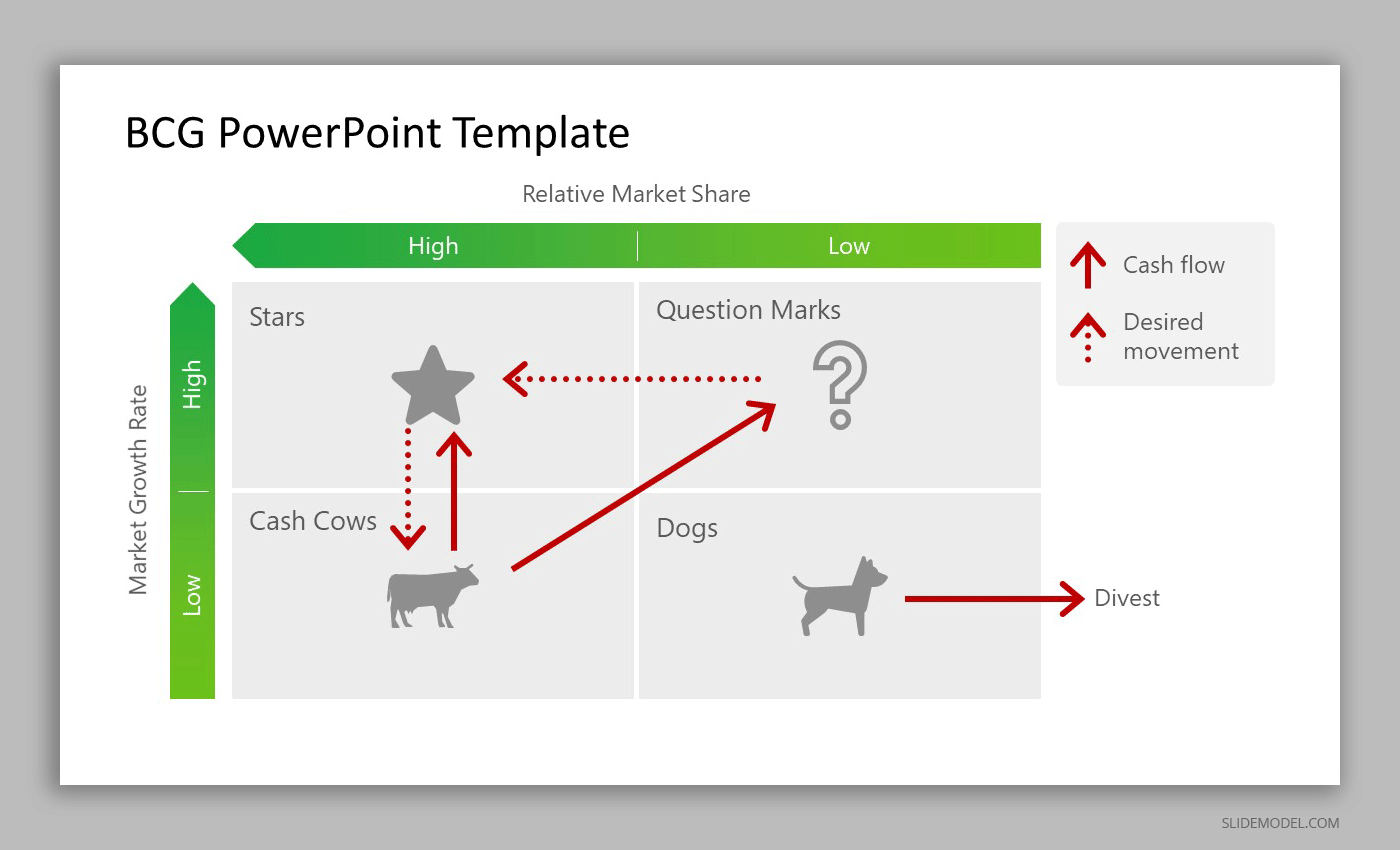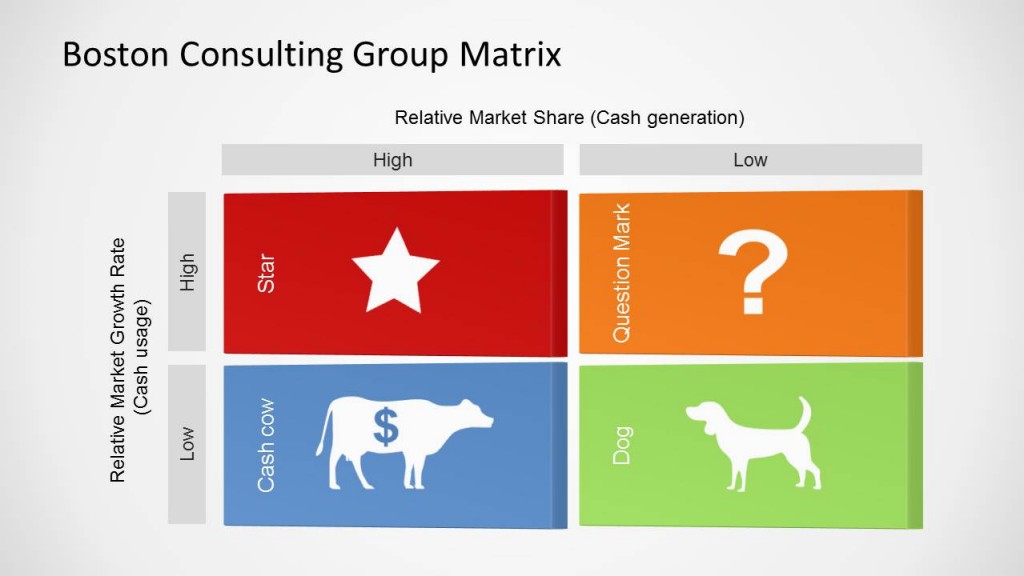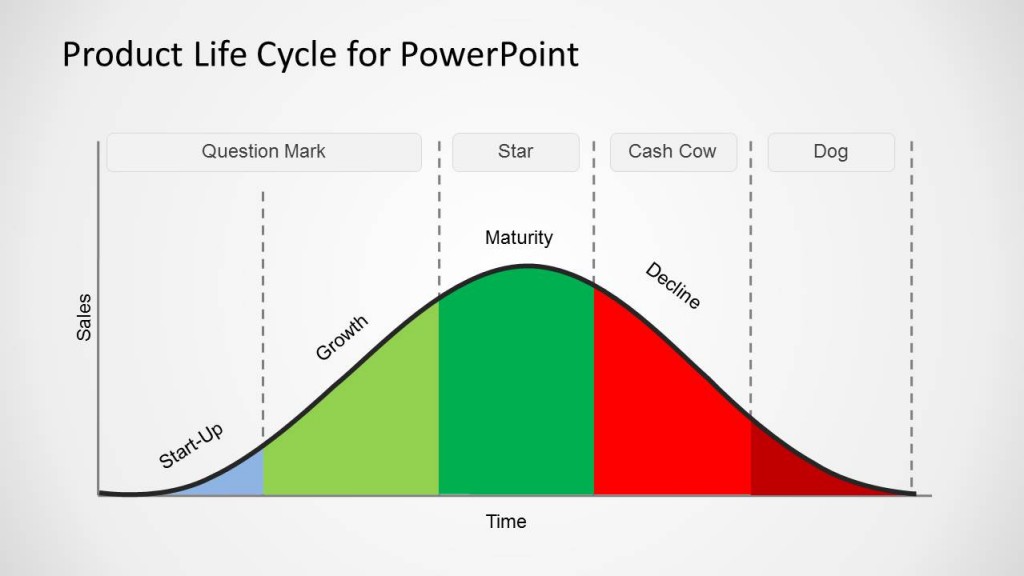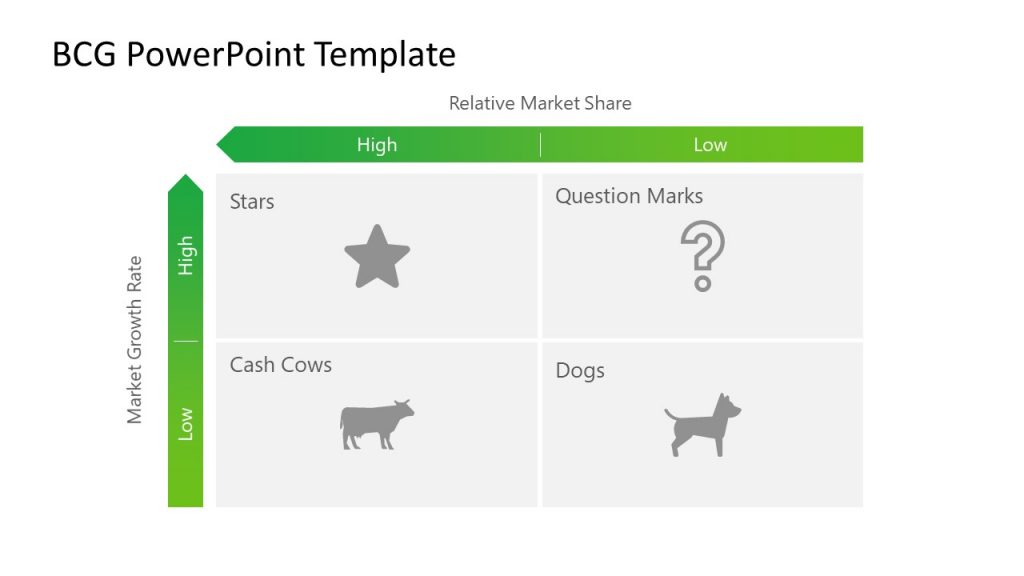
Companies dealing with multiple products can find it challenging to decide how to allocate resources for them. Some products might seem promising; however, the risk of failure can also be high. Similarly, well-established products might not need a lot of revenue to stay afloat in the market. Striking that delicate balance between how much to allocate and when to allocate funds for product management has long been answered by companies around the world by using the BCG Matrix.
What is the Boston Matrix?
The Boston Matrix, BCG Matrix or Growth-share Matrix is a chart that was developed by the Boston Consulting Group in 1970 to help businesses analyze their product lines. The chart was created by American management expert Bruce D. Henderson. BCG Matrix consists of a scatter graph to rank products or business units based on their market share and rate of growth. The products are divided into Stars, Question Marks, Cash Cows and Dogs.
Source: BCG PowerPoint template by SlideModel
Dogs
Dogs sometimes referred to as pets, have a low market share in a slow-growing industry. A dog belongs to an industry that has peaked and it is hard for less efficient products to stay afloat.
Question Marks
A question mark or problem child is a product that can either grow to become a star or downgrade and drop down to become a dog. As the name suggests, such a product operates with a low market share in a high growth market. Question marks are at times also called wild dogs or adopted children.
Stars
A star is a product with a high market share, in a market with high growth. These are question marks that were able to graduate to become stars. A star can eventually become a cash cow for a business.
Cash Cows
Cash cows have a high market share in an industry that has slowed down. The rule for cash cows is to milk them to fund question marks which might become future cash cows.
How to Implement the BCG Matrix?
The BCG Matrix is used by companies to understand product management. Let’s take a look at how companies can make use of the BCG Matrix to allocate resources for their products.
Remove Dogs from Portfolio
Dogs belong to a mature market and are units that are unable to make enough money to stay afloat. Dogs are break-even products, their revenue and market share is too low to justify their continuity. It is believed that dogs should be sold out or discontinued. This is because dogs can negatively affect a company’s portfolio.
Example: A TV manufacturer introduces a new type of TV
A TV manufacturer introduces a new type of TV, which uses a unique technology which is novel at the time. However, the TV consumes more electricity than another line of energy-efficient and better resolution TVs produced using even better technology. The product after a few years of heavy investment is barely able to produce any profit, operating at barely break-even. From an accounting point of view, the product is a liability and negatively affecting the portfolio of the company. The company decides to discontinue the product.
A real-life example of a Dog can be considered Phillips Plasma TV. Manufacturers like Phillips failed to survive in a growing Plasma TV market, also due to competition from more energy-efficient and cheaper LCD TVs. other key players such as Samsung and LG stayed in the market for a while until Plasma TVs became obsolete.
Question Marks Might Become Stars or Dogs
Since question marks operate in markets experiencing high growth, they have the possibility of growing into stars and eventually cash cows. On the contrary, products which fail to survive competition become dogs and need to be dealt with. Companies need to invest heavily in question marks in the hope of making them a success. For this purpose, companies milk their cash cows to fund question marks.
Example: A tech company launching a new web service in a growing market
A tech company launches a new web service in a growing market. The service becomes a question mark since it’s unable to experience the desired growth over five years. The company invests in R&D and provides additional features which become an instant success, leading to a surge in users.
Gmail for a very long period was not the preferred email service for many as Yahoo, Hotmail and AOL ruled the market. However, over time Gmail became a success story and changed the trajectory of Google, proving that the company could offer more than just its popular search engine. Gmail wasn’t much to talk about back in 2004 at the time of its beta release. In fact, despite offering more space than competitors, we can say that it had a rough few years. By 2012, Gmail had an estimated 425 million active users and gave competitors a run for their money. By 2019, Gmail had an estimated 1.5 billion users. Gmail not only earns revenue for Google by displaying ads but is also a part of its famous GSuite.
Milk Your Cash Cows
The simple rule for a cash cow is to milk it but not to kill it! Cash cows experience a high market share in an industry that is slow in growth. Investing too much in cash cows is counterproductive since they require little investment to stay afloat. Cash cows need to be milked for funding other products such as question marks which might become stars and later on, cash cows.
Example: A company launching a carbonated drink several decades ago
A company launched a carbonated drink several decades ago. The drink became an international success story and has been a top seller for many years. The market for carbonated drinks is saturated, with little scope for growth, however, the product continues to make the revenue for the company without the need for much investment. The product is now acting as a cash cow to fund other ventures for the company such as bottled water and coffee.
The famous iPhone or iPod range by Apple, Kellogg’s Corn Flakes and Coca-Cola are all examples of cash cows. These products operate in a market that has little to offer in terms of growth, however, they are well-established brands that require little investment to keep producing revenue and are market leaders in their respective industries.
Source: BCG Matrix PowerPoint template by SlideModel
Sustain Your Stars
Stars have a monopolistic or very dominant selling position. Stars require a lot of funding to stay ahead of the competition in a fast-growing industry. By the time growth slows down in the industry, stars can carve a niche and become cash cows or downgrade to dogs.
Example: A clothing brand launching a new line of jeans
A clothing brand launches a new line of jeans called ‘Eco X’ made using environmentally friendly production methods. At the time, the market for eco-friendly products has just begun to pick up. The company invests heavily in attracting new customers and operates on low revenue for three years, making the product a question mark. The dividend pays off as the new line of clothing becomes one of the top sellers for eco-friendly clothing over five years. By then, the demand for eco-friendly products reaches a tipping point. While Eco X has become a popular eco-friendly brand graduated from a question mark to a star and is now a cash cow, two other companies that competed in the market for similar products have discontinued their eco-friendly jeans because their products were downgraded from question marks to dogs.
In recent years, many clothing brands such as Dockers, Adidas, Reebok and Puma have been competing to produce eco-friendly clothing. While Adidas and Reebok are launching new eco-friendly products, Puma back in 2015 had to pull the plug on its eco-friendly product range.

Limitations of BCG Matrix
While the BCG model is an easy-to-use tool to help companies analyze their products, it can be difficult for small companies to classify products using the framework. Furthermore, the Boston Matrix model assumes that more investment can lead to potential gains by turning Question Marks into Stars or they can be downgraded to Dogs if the returns aren’t good enough. The growth-share matrix does not account for synergies, as some businesses operating at low revenue can have other benefits for companies. Some products might offer low revenue but they might dominate the market. One such example is razor blades which are produced at a very low cost and can dominate the market despite earning low revenue.
Final Words
The BCG matrix model has long been used by companies to analyze their products and manage resources to identify which products to invest in and which to let go. The model is simple and makes it easier to classify products. However, using the model recklessly and without careful analysis can end up giving a misleading analysis. Amazon.com, Inc. as a public company continued to operate at a loss for several years, taking 14 years to show real profitability. A model which is now being copied by other companies. Hence, the BCG matrix, despite being used for several decades might need some adjustment by the Boston Consulting Group to account for the changing landscape of how companies operate and make a profit in the wake of changing priorities for long-term strategic gains. However, it appears that the BCG Matrix will continue to be a useful model used by companies for product management, at least in the near future.







